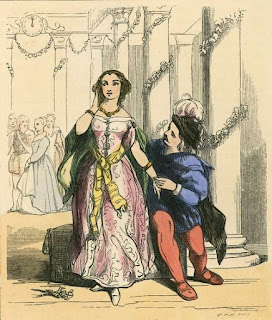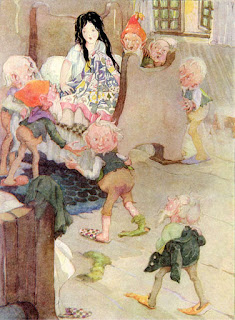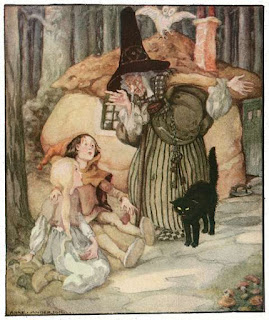Cinderella Images
The Biggest Collection of Free Cinderella Pictures on the Planet
While this title looks a bit bombastic, the simple fact is, that nowhere else you can't find more free images of Cinderella. All of them have known authorship and all the artists died more than 70 years ago, which makes all the presented paintings, illustrations, and other pictures Public Domain in the European Union and most other countries. Most of the images in this article were also created before 1923 which makes them Public Domain in the USA. In some very specific cases, an additional inquiry about copyright holders is suggested.
Let's look at the Cinderella pics!
John Absolon (1815-1895)
The glass slipper fits perfectly.
Frank Adams (1871-1944)
Anne Anderson (1874-1952)
The illustration was published in Anne Anderson's Old, Old Fairy Tales, published by Whitman Publishing Company, Wisconsin in 1935.Richard Andre (1834-1907)
Cinderella with the fairy godmother.
Will the slipper fit?
credit: https://richard-andre.jimdosite.com/picture-books/
Johannes Anker (1873-1950)
The decorative border stands out in this case. Hanns (Johannes) Anker was pretty well-known for his ornaments and other decorative elements.
Honor Charlotte Appleton (1879-1951)
A melancholic view of Cinderella in the kitchen.
The end of magic - horses became mice again!
Georges Barbier (1882-1932)
The artist decided to give a few moments of glory to Cinderella's sisters in his "The Ugly Sisters from Cinderella" drawing. While he was French, he eventually decided to use the German version with ugly stepsisters (Perrault's are almost as beautiful as Cinderella) to better fit his goal.
In this case, Georges Barbier decided to portray the happy couple but with her stepmother in the scene which creates another interesting tension.
Aubrey Beardsley (1872-1898)
This pen and ink drawing is titled The Slippers of Cinderella and was made for Le Courrier Francais in 1895.
Thekla Brauer (?-1943)
Illustration from Fifty Children's and Household Tales, published in 1895 by Otto Spamer in Leipzig.
Frances Brundage (1854-1937)
This illustration is titled "It Sounded Like Fairies Playing On Little Harps".
Gertrud Caspari (1873-1948)
The always popular scene with birds. They were very important symbols used by the Brothers Grimm.The scene with the lost golden (!) slipper.
Harry Clarke (1889-1931)
Harry Clarke was best known for his stained-glass art. There is a theory that his illustrations with a very special feel of characters are at least partly so different thanks to intoxication with poisonous fumes used for stained glass art.
Fanny Corbaux (1812–1883)
Marie Francoise Catherine Doetger "Fanny" Corbaux was a British painter with French roots. She invented calcimine. Calcimine is a whitewash with zinc oxide, used for whitening the inside walls.George Cruikshank (1792-1878)
George Cruikshank used the scene from Cinderella for a caricature, published in one of the numerous papers he worked for. It is not known who colored the engraving.
Howard Davie (1868-1943)
This specialist for watercolors illustrated almost exclusively for Raphael Tuck & Sons.
Thomas Edward Donnison (1861-1903)
The picture above comes from Old Fairy Tales Told Anew, published around 1900 by Raphael Tuck & Sons in London.
Gustave Dore (1832-1883)
Amusing engraving by one of the greatest illustrators ever is colored by an unknown artist.
Gustave Fraipont (1849-1923)
An interesting take on illustrating from times when new media - comics - was born.
Warwick Goble (1862-1943)
One of 32 color illustrations from The Fairy Book, published by MacMillan, in 1913.
Frederick Hall (1860-1948)
Fred Hall was an impressionist painter who loved portraying rustic scenes as is evident in the painting of Cinderella as well.
John Hassall (1868-1948)
Poster in two colors only.
Poster in full-color printing technique.
Theodor Herrmann (1881-1926)
This illustration was initially made for wall decorations in schools. In 1915 a book of fairy tales with some of his illustrations was published. Cinderella was one of them.
Paul Hey (1867-1952)
The scene with birds as Ascenputtel's helpers.
The grand finale with the prince.
Another scene with birds in the kitchen, this time for the postcard.
Daan Hoeksema (1879-1935)
This artist is more known as an author of comic books yet he created several picture books as well, most of them for Gebroeders Koster. He also designed postcards. We don't know on what occasion his Aschenputtel was created.
Marie Hohneck (1866-1949)
The illustration comes from the collection Golden Fairy Tales, published by Wise, Stuttgart in 1905 with 12 picture books and 96 illustrations altogether.
Maud Humphrey (1868-1940)
Cinderella with her fairy godmother.
Cinderella is running away and losing her glass slipper.
Eugen Johann Georg Klimsch (1839-1896)
Eugen Klimsch illustrated the scene with trying the slipper in 1894, as one of his last projects. The collection of his pictures was reprinted in 1923.Otto Kubel (1868-1951)
Otto Kubel was a popular illustrator and postcard designer, so he used this (and many others) image for books and postcards.
John Lawson (1838-1908)
This illustration comes from There Was Once, a collection of fairy tales by Constance Wilde.
Frederic Theodore Lix (1830-1897)
T. Lix created this illustration for Perrault's Fairy Tales, published by Garnier Freres around 1904.
Emil Lohse (1885-1949)
William Henry Margetson (1861-1940)
Margetson's illustration from Perrault's version of Cinderella (there is no fairy in German variation) is from The Old Nursery Stories, published in 1909.
The illustration belongs to the album of Emil Lohse's pictures without text. It was published right after WW2 at least three times in five years.
Emile Meyer (1823-1910)
The oil on canvas painting is dated 1898. The title is Cinderella and Her Wicked Sisters.
Henri Meyer (1841-1899)
Henri Meyer was a successful illustrator and caricaturist in the second half of the 19th century. The illustration above was done for the poster promoting a theatre play.
Paul Meyerheim (1842-1915)
Ascenputtel in a classic scene with birds, her magical helpers, from 1874.John Everett Millais (1829-1896)
John Everett Millais is the founder of the Pre-Raphaelite Brotherhood. Like most of its members, he enjoyed painting redheads and his vision of Cinderella was no exception.
Lucien Pissarro (1863-1944)
Lucien was the son of the more famous Camille, one of the leading French impressionists.
Elenore Plaisted Abbott (1875-1935)
"Rustle and shake yourself, dear tree. And silver and gold throw down to me." Plaisted Abott's Cinderella from 1920 is actually Aschenputtel - Grimm's not Perrault's variation of the same story with a tree instead of a fairy godmother.
Valentine Cameron Prinsep (1838-1904)
The painting was made in 1899. Oil on canvas with 150 cm of height is owned by Manchester City Art Galleries.
Hans Printz (1865-1925)
Not much is known about this Austrian painter.
Arthur Rackham (1867-1939)
Arthur Rackham illustrated several different collections of Grimms' Fairy tales between 1909 and 1939. The version above is from 1917.
Walford Graham Robertson (1866-1944)
Illustrations were just a tiny part of the opus by this multi-talented artist and collector. We don't know on what occasion this version of Cinderella was created.
Charles Robinson (1870-1937)
Unfortunately, we don't have any useful information about the picture above.
This illustration is one of several (but the only one in color) illustrations of Cinderella in The Big Book of Fairy Tales published by Blackie & Son, London in 1911.
The picture is titled Little Glass Slipper. It was made in 1900 for Tales of Passed Times (with fairy tales by Charles Perrault, Madame d'Aulnoy, and Jeanne-Marie Leprince de Beaumont) for J M Dent & Company, London.
Eugen Siegert (1858-1906)
This illustration was created around 1900, very likely a few years after 1900.
Franziska Schenkel (1880-1945)
This is one of eight chromolithographs by the same artist, published in the anthology Grimm's Fairy Tales in 1913 by Steinkamp Verlag, Duisburg.
Fritz Schoen (1871-1929)
The picture above belongs to a series of six illustrations by the same artist made for collectors and promoting food factory Palmin.
Georg Albert Stroedel (1870-1938)
This is just one of six pictures from different editions published by Josef Scholz Verlag between 1910 and 1920 in Mainz.
Evelyn Stuart Hardy (1866-1935)
While E. S. Hardy created a lot and was pretty popular in her lifetime, we don't know much about her and her work. We know that her real name was Beatrice Evelyn Elizabeth Hardy but are not sure even about her birth date. Definitely an artist to explore in the future.
Thomas Sully (1783-1872)
Oil on canvas was created in 1843. Today it belongs to the Dallas Museum of Art.Hermann Vogel (1854-1921)
To avoid confusion with his contemporary with the same name he often used the name Hermann Vogel-Plauen. Plaun was his birthplace. Otherwise, he also belongs to artists who loved decorative borders and skillfully used them.
Edward Henry Wehnert (1813-1868)
The painting titled "Aschenputtel and the Prince" was created in 1901, half a century after the creator of the original drawing already died. We will never know who colored Wehnert's creation.
Jessie Willcox Smith (1863-1935)
Probably the best American illustrator ever obviously liked the scene of Cinderella at the heath. She portrayed the girl twice in very similar positions but with different color palettes.
This picture was used for a very successful calendar, published at the end of 1915 (for the year 1916) by Swift, a popular seller of food and hygienic products.
Alexander Zick (1845-1907)
This illustration was published around 1885 in Fairy Tales for Children, published by G. Grote'sche Verlagsbuchhandlung. It's a collection of about 20 fairy tales by Ludwig Bechstein and Grimms.Ernst Zimmer (1864-1924)
Ernst Zimmer illustrated six fairy tales in the anthology The Most Beautiful Fairy Tales by the Brothers Grimm, published in 1904 by Jugendhort. Aschenputtel is, of course, one of them.
This is not the end, just a break. We will add at least twenty more illustrations in the near future. In the meantime, you can help us by telling your friends about this page. It's created to be shared!





































































Komentarji
Objavite komentar